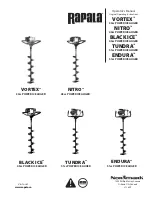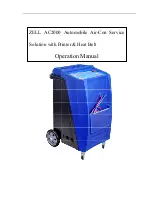
TROUBLE SHOOTING GUIDE FOR UNITS WITH DX COOLING
14
7.
Refrigerant Overcharge
- An overcharge of refrigerant causes a portion of the condenser tubes to become
flooded with liquid, or submerged in liquid in the case of the water-cooled condenser, reducing the effective
condensing surface. This increases the condensing temperature and pressure, resulting in possible trip-out on the
high-pressure control or compressor overloads. The refrigerant overcharge is removed by connecting a refrigerant
cylinder to the liquid line-charging valve; starting the system and opening the charging valve. Since the pressure
within the liquid line is greater than that in the cylinder, refrigerant will flow into the cylinder. Icing the cylinder
will further reduce the pressure, speeding the removal of refrigerant. Remove enough refrigerant to return the
condensing pressure to normal.
8.
Improperly Sized Expansion Valve
- An oversized expansion valve will generally overfeed the evaporator at part
load, however at full load, it will perform satisfactorily. The reason being, at part load the valve attempts to control
at its superheat setting but its oversize port allows liquid to pass too rapidly. This over-feeds the evaporator, causing
a reduction in the superheat of the leaving gas. In response, the valve closes until normal superheat is re-established.
At this point, the valve again opens to pass another slug of refrigerant. This "hunting" condition causes the suction
pressure to vary and may not allow liquid to pass into the suction line. An undersize valve, on the other hand,
controls well at part load demand. Under conditions of rising system demand, the evaporator capacity falls behind
the load, and the superheat rises.
The Trane Company: La Crosse, Wisconsin, Trane Reciprocating Refrigeration: Copyright 1946, 1956, 1961,
1964, 1966, 1977









































